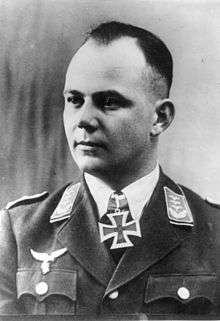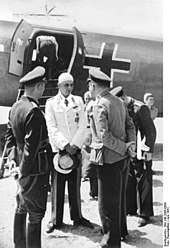Walter Koch (Fallschirmjäger)
Walter Koch (10 September 1910 – 23 October 1943) was a commander of the Fallschirmjäger during World War II who died in mysterious circumstances after openly criticising Adolf Hitler.[1] Koch, who was the recipient of the Knight's Cross of the Iron Cross for his actions during the Battle of Fort Eben-Emael in May 1940, had publicly denounced the Führer's infamous Commando Order, which ordered that all captured enemy commandos were to be executed. Shortly afterwards the Oberstleutnant and commander of Fallschirmjäger-Regiment 5 died in Berlin from injuries allegedly resulting from a motor vehicle collision.[1]
- For other persons named Walter Koch see Walter Koch (disambiguation).
Walter Koch | |
|---|---|
 Walter Koch Note that the Knight's Cross at his neck is a photomontage | |
| Born | 10 September 1910 Bonn, Rhine Province, Kingdom of Prussia, German Empire |
| Died | 23 October 1943 (aged 33) Berlin, Free State of Prussia, Nazi Germany |
| Allegiance | |
| Service/ | |
| Years of service | 1929–1935 (Police) 1935–1943 (Luftwaffe) |
| Rank | Oberstleutnant |
| Unit | 1. Fallschirmjäger-Division |
| Commands held | Sturmabteilung Koch |
| Battles/wars | World War II
|
| Awards | Knight's Cross of the Iron Cross |
| Other work | Police officer |
Early career
Walter Koch joined the Landespolizei as an officer on 3 April 1929. As a Leutnant he had served in the state police and a police battalion for special purposes (Polizeiabteilung z.b.V. Wecke). In 1935 the new commander-in-chief of the Luftwaffe, Hermann Göring, transferred this police unit into the reformed Luftwaffe and renamed it the Regiment "General Göring".[2]
Airborne service

Koch was promoted to Hauptmann (Captain) on 20 April 1938. He was then tasked with training a special commando unit dubbed Koch Parachute Assault Battalion (Fallschirmjäger-Sturm-Abteilung "Koch") for operations in the west.
When Fall Gelb began in May 1940, his troops saw action during the opening phase of the Battle of France during assaults on the Belgian fortress Eben-Emael, the Maas river and Albert Canal bridges. Koch's commandos successfully captured Fort Eben-Emael and the bridges in Veldwezelt and Vroenhoeven. Only the bridge at Kanne, which was blown up by the Belgian defenders, was not taken by the German paratroopers. For these successful operations, Walter Koch along with ten other Wehrmacht officers received the Knight's Cross of the Iron Cross.
By May 1941, Koch was promoted to Major and given the command of the re-designated I Battalion, 1st Parachute Assault Regiment (I./Luftlande[3]-Sturm-Regiment 1) The battalion was part of the first attacking airborne waves during the Battle of Crete. Koch led the attack using 53 DFS 230 troop-carrying gliders. Their target was the village of Maleme on the western coast of Crete because its small coastal airfield and Hill 107 commanded the approaches to the island's capital. The German troops faced the New Zealanders of 5 Brigade's 22nd Battalion, with other battalions close behind, under the command of Brigadier Edward Puttick. Although Koch was wounded in the head in the battle for Hill 107 on the first day, his airborne troops quickly achieved their targets.
Koch was promoted to Oberstleutnant (Lieutenant Colonel) on 20 April 1942. He and the 5th Parachute Regiment (Fallschirmjäger-Regiment 5) were transferred to Tunisia in mid November 1942.
Death
Shortly after stopping the killing of POWs in North Africa, Koch was wounded in the head. The highly experienced combat leader was sent back to Germany to recover from his wounds; while there he was placed in the Führerreserve.[2] While convalescing he was involved in car accident, he died in a Berlin Hospital from these injuries in October 1943. However many in his regiment believed that this was no accident and he had been most likely killed by the SS-Reichssicherheitshauptamt because of his outspoken criticism of the Commando Order.[1]
Awards
- Iron Cross (1939)
- Knight's Cross of the Iron Cross on 10 May 1940 as Hauptmann and commander of Fallschirmjäger-Sturm-Abteilung "Koch"[5][Note 1]
- German Cross in Gold on 31 March 1942 as Major in the I./Luftlande-Sturm-Abteilung[7]
Notes
- According to Scherzer as commander of Luftlande-Sturm-Abteilung "Koch".[6]
References
Citations
- Quarrie, Bruce (1983). German Airborne Troops 1939–45. Osprey Publishing. p. 18. ISBN 978-0-85045-480-2.
- Quarrie 2005, p. 13.
- Tessin . Verbaende und Truppen der deutschen Wehrmacht und Waffen SS, Zweiter Band, p. 64
- Thomas & Wegmann 1986, p. 139.
- Fellgiebel 2000, p. 264.
- Scherzer 2007, p. 456.
- Patzwall & Scherzer 2001, p. 240.
Bibliography
- Fellgiebel, Walther-Peer (2000) [1986]. Die Träger des Ritterkreuzes des Eisernen Kreuzes 1939–1945 — Die Inhaber der höchsten Auszeichnung des Zweiten Weltkrieges aller Wehrmachtteile [The Bearers of the Knight's Cross of the Iron Cross 1939–1945 — The Owners of the Highest Award of the Second World War of all Wehrmacht Branches] (in German). Friedberg, Germany: Podzun-Pallas. ISBN 978-3-7909-0284-6.
- Patzwall, Klaus D.; Scherzer, Veit (2001). Das Deutsche Kreuz 1941 – 1945 Geschichte und Inhaber Band II [The German Cross 1941 – 1945 History and Recipients Volume 2] (in German). Norderstedt, Germany: Verlag Klaus D. Patzwall. ISBN 978-3-931533-45-8.
- Quarrie, Bruce (2005). German Airborne Divisions: Mediterranean Theatre 1942–45. Oxford, UK: Osprey Publishing. ISBN 978-1-84176-828-1.
- Scherzer, Veit (2007). Die Ritterkreuzträger 1939–1945 Die Inhaber des Ritterkreuzes des Eisernen Kreuzes 1939 von Heer, Luftwaffe, Kriegsmarine, Waffen-SS, Volkssturm sowie mit Deutschland verbündeter Streitkräfte nach den Unterlagen des Bundesarchives [The Knight's Cross Bearers 1939–1945 The Holders of the Knight's Cross of the Iron Cross 1939 by Army, Air Force, Navy, Waffen-SS, Volkssturm and Allied Forces with Germany According to the Documents of the Federal Archives] (in German). Jena, Germany: Scherzers Militaer-Verlag. ISBN 978-3-938845-17-2.
- Thomas, Franz; Wegmann, Günter (1986). Die Ritterkreuzträger der Deutschen Wehrmacht 1939–1945 Teil II: Fallschirmjäger [The Knight's Cross Bearers of the German Wehrmacht 1939–1945 Part II: Paratroopers] (in German). Osnabrück, Germany: Biblio-Verlag. ISBN 978-3-7648-1461-8.
| Military offices | ||
|---|---|---|
| Preceded by none |
Commander of Luftlande-Sturm-Regiment 1 2 November 1939 – 31 August 1940 |
Succeeded by Generalmajor Eugen Meindl |